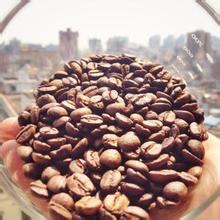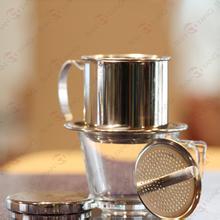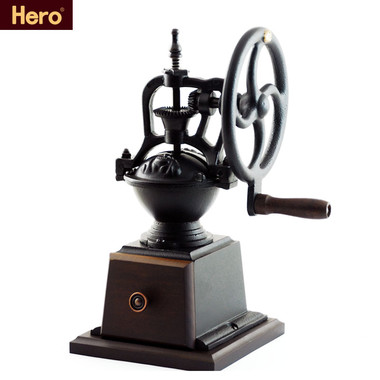Operation Technology of Italian Coffee: detailed introduction of Espresso blending Bean production Technology
In general, larger coffee beans produce better coffee. In the case that the quality of coffee beans has been fully grasped, the first technical problem to be solved is "blending". "Blending" refers to the selection of coffee beans of different origins and qualities to achieve the desired result. The "Blending Tech School" believes that 50% of the success of the perfect Espresso depends on the composition and quality of the blend. No single origin coffee can achieve the full flavor of Espresso. African and Arabian coffee trees produce coffee beans characterized by complexity, berry volume, and floating aroma; Latin American coffee is characterized by clean, strong, and refreshing coffee; Southeast Asian coffee is characterized by full fruit and earthy flavor. Many coffees are a mixture of several types of coffee, which makes the taste more complex.
Espresso cooked at the ideal temperature is very dark reddish-brown, the surface foam will have dark brown spots (Italians call it "el tigre"(tiger stripes), and the foam thickness should be more than 4 mm.
The perfect blend is not a random blend of several fine coffee beans. The basic blending process is to first determine the reference beans, then add coffee beans that can increase the aroma and special flavor, and make up the blended coffee according to the mixing ratio of various beans and the degree of roasting. Blending with the original beans required to have their own characteristics, to avoid similar flavor. The number and proportion of coffee bean types are constantly tried, so most of them use mathematical combination to draw up a blending plan before blending, and then determine the best plan through the process of blending cups.
Bake first and then mix, or mix first and bake? This has always been the subject of debate between bakers and composers. As with wine blending, blending before roasting can make aroma and quality more uniform, but must take into account the roasting of the "decline", because different origins of coffee require different roasting time and temperature. If there is a definite recipe, you can mix different coffee beans first and then roast them together. Most established coffee makers have their own secret recipes.
In contrast to Blending Tech, Roasting Tech believes that 80% of coffee's flavor depends on roasting. Ignoring percentage data, whether or not you are particular about "roasting" or whether you roast yourself, this has indeed become an important indicator of the identity of a coffee glutton. "Roasting" refers to roasting raw coffee beans with a special machine, so that coffee beans present a unique coffee color, aroma and taste, the point is that the inside and outside of the beans are evenly "fried" and not burnt. Baking produces a series of chemical changes: moisture drops from 10% to 1%, fat increases from 12% to 16%, sugar drops from 10% to 2%, chlorogenic acid drops from 7% to 4 - 5%, and nitrogen increases from 12% to 14%. Physical changes are: water loss, weight loss of 10% to 15%, volume increase of 60%.
A figurative metaphor is: "A toaster is a machine between a popcorn machine and a clothes dryer." The temperature in large industrial roasting barrels can reach 288 degrees Celsius, and the coffee beans turn yellow first and emit the smell of popcorn. After about 8 minutes, it starts to crackle and expand. When the temperature reaches 204 degrees Celsius, the coffee beans begin to turn brown and the oil inside begins to spill. The spilled oil is known as "coffee extract" or "caffeol," and the chemical reaction between heat and caffeol is known as "pyrolysis," which produces the strong coffee flavor. After another three to five minutes, the machine will make a crackling sound again, and the color of the coffee will soon change to dark, indicating that it has been roasted. When the preset baking temperature is reached, the baking can be stopped with cold air. Roasted coffee beans have no wrinkles on the surface and are glossy and symmetrical, fully demonstrating their unique flavor. If you bake too quickly at the beginning, the beans will appear spots on the skin and the taste will become bitter and pungent.

In 1992, the second generation of illy management commissioned architect Matteo Thun to design a set of white coffee porcelain cups, which gave birth to a series of popular illy coffee collection cups. Every year illy invites modern artists to collaborate on the design of its annual collection cup. Despite the variety of finishes, the cup itself strictly follows the illy family definition of the perfect espresso cup: "small, thick-walled porcelain cup with a capacity of no more than 50 ml... small in volume to ensure a more concentrated brew; synthetic materials used to ensure that the foam and liquid parts are equally clear."
Roasting is generally divided into three levels: light, medium and deep, and the length of roasting time varies according to the type of coffee required. Lightly roasted beans are light in color and sour, medium roasted beans are medium sour and bitter, and deep roasted beans are strong in color and bitter in taste. The lighter the roast, the stronger the sourness of the coffee beans, the deeper the roast, the less sourness, and the more bitter. Professional baking is generally divided into eight stages: Light Roast, Cinnamon Roast, Medium Roast, High Roast, Cicty Roast, Full-City Roast, French Roast, and Italian Roast. Among them, ultra-deep baking, also known as "Italian baking," is mainly popular in Latin countries and is considered the best for Espresso. Very dark roasted coffee beans are black in color, and the oil has penetrated to the surface, so it has a bitter taste of carbon ash, and the alcohol is obviously reduced.
For some strict roasting techniques, the roast coffee used for Espresso also needs to be fresh, so it is required to use coffee that has been roasted for four days. But I'm afraid this rule only applies to those who bake on their own small machines. Big coffee plants have patented technologies to ensure that roasted coffee beans are kept airtight. One of the most famous is Illy's patented inert gas preservation method, which works by evacuating the air from the container and filling it with pressurized inert gas. Observed under the electron microscope, it can be confirmed that coffee cell tissue originally scattered coffee oil, after pressurization, these oils will be concentrated around the cell wall, some of the cells rich in aroma, highly volatile chemicals wrapped up, thus isolated from air contact, to avoid oxidation. This technique is believed to preserve the flavor and freshness of roasted coffee beans for up to three years.
Source:
Coffee instructor blog
Important Notice :
前街咖啡 FrontStreet Coffee has moved to new addredd:
FrontStreet Coffee Address: 315,Donghua East Road,GuangZhou
Tel:020 38364473
- Prev

Coffee brewing method: introduction of matters needing attention in Vietnamese trickle-filter coffee diet
Many young friends in life like to drink coffee, which can wake your brain up instantly and relieve the fatigue of your brain. Of course, there are many taboos about drinking coffee. Drinking the wrong coffee will hurt the body. Here are some taboos to pay attention to when drinking Vietnamese coffee. 1. Avoid Vietnamese coffee when drinking. Drinking liquor with drinks containing Vietnamese caffeine will aggravate the effect of alcohol on the human body.
- Next

Operation technology of Italian coffee: grinding technology of coffee beans made by Espersso
The thickness of coffee beans depends on the way they are cooked. Generally speaking, the longer the cooking time, the thicker the ground powder. In terms of actual cooking, American filter coffee takes a long time to make, so coffee powder is the thickest, siphon coffee takes more than a minute to cook, and coffee powder is medium in size; Espresso takes the shortest time, so it needs the most grinding particles.
Related
- What is the meaning of lactic acid fermentation with coffee bean treatment?
- How to judge the state of foam by sound?
- How does the latte pull out the unicorn pattern? Come to get for a little trick to improve the flower pull!
- Will flower pulling affect the taste of the latte?
- Do you know the history of coffee?
- The difference between honey treatment and sun washing what is raisin honey treatment?
- What kind of milk can a novice use to make coffee foam to keep the foam longer? The correct method and skills of milking tutorial sharing
- Why do washed coffee beans taste sour? Flavor characteristics of washed Coffee
- Introduction to the skill of how to practice the size and height of water injection around the circle of hand-brewed coffee
- How do beginners practice coffee flower drawing from scratch?

